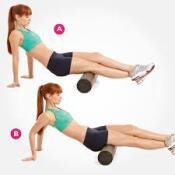The Benefits of Foam Rolling….Even for Healthy Runners!
Do you generally feel fine after your runs? No real aches or pains, or at least none that are limiting your running? A frequent question that I get asked is, if I am feeling good, why should I use a foam roller (or other massage tool)?
The benefits of foam rolling have to do with the mobility of the fascia. Fascia is a fibrous layer of connective tissue that surrounds all of the muscles in our body. Without proper mobility, fibers of the fascia become cross linked and they bind to muscles and nerves, inhibiting normal motion and causing pain. Many runners will stretch to try to keep their muscles healthy, but is stretching really enough?

Stretching may be more beneficial if foam rolling is done prior to the stretch. A recent study (Foam Rolling and Static Stretching on Passive Hip Flexion Range of Motion) that was accepted for publication in the Journal of Sport Rehabilitation in January of 2014 measures the effects of foam rolling prior to static stretching. The authors found an increase in hip range of motion after rolling on the hamstring then stretching, compared to stretching alone. Increase in flexibility was thought to be from increased blood flow and an increase in intramuscular temperature, both of which increase the viscoelastic properties of muscle.
Much of the research is suggesting that static stretching prior to exercising is not beneficial and could actually be injurious. Many people suggest that static stretching be performed after exercise, when muscles are relaxing and returning to their normal length. The results of the aforementioned study suggest that it might be even more beneficial to precede that post exercise static stretch with a form of Self Myofascial Release (SMR) such as foam rolling.
There are a few reasons why SMR can benefit you. To learn more and to find out how a metronome can help you with your foam rolling, click here.
Daily Health of Fascia
Fascia is continually being created and laid down throughout our body. Without proper movement, the fibers will not form in the correct pattern, creating pain and inhibiting movement. The stresses that we put on our bodies every day can affect how fascia is laid down. Those stresses can range from running, carrying a heavy work bag on our shoulder, sitting at a computer, or any other activity that we perform regularly! SMR will keep trigger points and scar tissue broken up within the muscle and fascia, allowing greater tissue extensibility, normal function, and normal motion.
Post Injury Tissue Mobility
The concept of tissue mobility is of even greater importance after injury because new layers of fascia are laid down as scar tissue. If this tissue isn’t broken up, mobilized, and properly aligned, it can cause problems in the future. Even if you had an injury a while ago (months to years) it can still creep up on you and cause problems. Many times, when I’m evaluating an injury, the more I get into the history of pain with the person, the more past injuries are revealed. They might have never have completely resolved or properly rehabilitated an old injury, but never traced their current issues back to that injury.
Scar tissue from past injuries will inhibit normal tissue mobility and function. You might be able to continue running because the body will compensate, but there are underlying issues of tissue mobility that might affect you down the line in your training. If you are running (or doing any sort of exercise) on a regular basis, it’s important to keep muscles and fascia healthy and mobile. It might help prevent some of those injuries that pop up during training when you thought you were feeling fine. I’m referring to all of those nagging injuries that many runners just accept as part of being a runner; hamstring tightness, achy Achilles tendon, or sore knees, to name a few. All of those things could potentially be traced back to poor tissue mobility.
Performance Capability of Flexible Tissue
Another benefit to regular SMR is the performance capability of your muscles. The more flexible your muscles are within normal range of motion, the more power they will be able to produce. This has to do with elastic energy. The more stretch a muscle gets, the more stored energy it has, the more force it will be able to generate. On the other hand, a less flexible muscle produces less stretch, less range of motion, less stored energy, and decreased force output. SMR, combined with proper stretching, strengthening, and training could help you reach new performance levels that you were never able to achieve before. SMR has become standard practice among many collegiate and professional level athletes across all sports because of the perceived performance benefits.
How long / often should I use the foam roller?
SMR can be done daily. In the study, subjects performed three, one minute sessions at a rate of 60bpm. We usually use metronomes (small beeping devices) to track our running cadence. In the study, they used a metronome set at 60 bpm to ensure one second down roll, one second up roll. Now you have another use for your metronome (if you don’t have one, you can download an app)!

When you perform SMR, you want to make sure you roll along the whole length of the tissue that you are working on. If it’s your hamstring, you are going to roll from hip to knee. The same goes with the quadriceps and IT Band. There will be some tender spots along the way. That’s ok. Go over them, they will decrease in tenderness with regular SMR.
Latest News
Upcoming Events
CommUNITY Fun Run
8:30am - 9:30am | Fleet Feet - Hartford, 1003 Farmington Ave, West Hartford, CT 06107
Join Fleet Feet staffer & Hartbeat Track Club member, Tommy O'Gorman, for a run through the …
Learn More ›CommUNITY Fun Run
6:15pm - 7:15pm | Fleet Feet - Hartford, 1003 Farmington Ave, West Hartford, CT 06107
Running is about a lot more than logging miles and collecting race medals. Running communiti…
Learn More ›
Connect With Us
see the latest from Fleet Feet Sports West Hartford